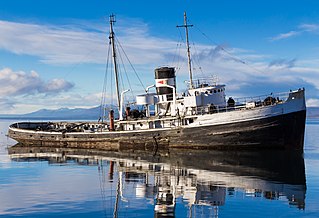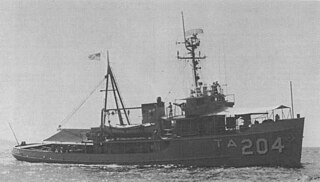
USS Zuni (AT/ATF-95), a Cherokee-class fleet tugboat, formerly called Navajo class, was a ship of the United States Navy named for the Zuni, the popular name given to a tribe of Pueblo Indians indigenous to the area around the Zuni River in central New Mexico near the Arizona state line.

USS Reeves (DE-156/APD-52) was a Buckley-class destroyer escort in service with the United States Navy from 1943 to 1946. She was transferred to Ecuador for use as an electric generator plant in 1960. Her final fate is unknown.

HMS Justice (W-140), a Royal Navy ship classified as a rescue tug, was built in the United States as U.S. Navy ATR-1-class rescue tugUSS ATR-20. Never commissioned into the U.S. Navy, she was transferred to the Royal Navy under Lend-Lease at delivery. Returned to the U.S. after the end of World War II, she was redesignated BATR-20. Struck and sold for commercial service in 1946, she was eventually grounded at Ushuaia, Argentina and abandoned.
USS Buoyant (AM-153) was an Admirable-class minesweeper built for the U.S. Navy during World War II. After service in the Pacific, which netted her crew one battle star, she was decommissioned in May 1946 and sold to the Republic of China. Her name in Republic of China Navy service and her fate are not reported in secondary sources.

USS Chickasaw (AT-83/ATF-83) was a Navajo-class fleet tug constructed for the United States Navy during World War II. She served in the Pacific Ocean in World War II and the Korean War, and was awarded six battle stars for World War II and two battle stars during the Korean War.
USS Tackle (ARS-37) was a Tackle-class rescue and salvage ship acquired by the U.S. Navy during World War II. She served in the dangerous North Atlantic waters, and returned home proudly at war's end with two battle stars.
USS Challenge (ATA-201) was a Sotoyomo-class auxiliary fleet tug acquired by the United States Navy for service during and after World War II.
USS ATA-176 was an ATR-1-class rescue tug built for the United States Navy during World War II. She was laid down on 30 January 1944 and launched on 1 March as USS ATR-103, but was re-designated ATA-176 on 15 May. She was commissioned as USS ATA-176 on 19 August. She served in the U.S. Pacific Fleet during the war and was decommissioned on 30 June 1947. She was then manned with a civilian crew and placed in service, being renamed USNS Tonkawa (T-ATA-176) on 16 July 1948. Tonkawa, the first U.S. Navy vessel named for the Tonkawa, was taken out of service in 1956 and placed in reserve.

USS Coos Bay (AVP-25) was a United States Navy Barnegat-class small seaplane tender in commission from 1943 to 1946 that saw service during the latter half of World War II. After the war, she was in commission in the United States Coast Guard from 1949 to 1966 as the cutter USCGC Coos Bay (WAVP-376), later WHEC-376.
USS Kalamazoo (AOG-30) was a T1-M-A2 Mettawee-class gasoline tanker acquired by the U.S. Navy for the dangerous task of transporting gasoline to warships in the fleet, and to remote Navy stations.

USS Wateree (ATF-117/AT-117) was an Abnaki-class fleet ocean tug acquired by the U.S. Navy during World War II. Wateree was sent to the western Pacific Ocean to perform towing services; however, during a typhoon, she was damaged beyond repair and lost, with eight crew members missing.
USS Wateree (ATA-174), the third ship named USS Wateree, was a Sotoyomo-class auxiliary fleet tug in the service of the United States Navy during World War II. She later served with the Military Sea Transportation Service and the Peruvian Navy as a diving support ship. In Peruvian naval service she was renamed BAP Unanue (ATA-136).

The second USS Wandank (ATA-204), originally USS ATA-204, was a United States Navy auxiliary ocean tug in commission from 1945 to 1947 and again from 1952 to 1971. The ship is possibly best known for supporting scientific operations in the Marianas, in particular serving as communication relay and support ship for the bathyscaphe Trieste in Project Nekton; she towed the bathyscaphe some 260 nautical miles from Guam to the vicinity of the Challenger Deep, where, on 23 January 1960, Trieste descended to a record 10,911 metres.
USS Sotoyomo (ATR-43/ATA-121) was a rescue tug of the United States Navy that served during World War II and the early 1950s, and was sold to Mexico in 1963.
USS Sonoma (ATA-175) was a tugboat of the United States Navy, which served during World War II. She was the third Navy ship to bear the name "Sonoma", which is of American-Indian origin, in accordance with the Navy's naming convention for tugs.

USS Geronimo (ATA-207) an auxiliary ocean tug, was built by the Gulfport Boiler and Welding Works of Port Arthur, Texas, and originally designated ATR-134. Launched 4 January 1945 as ATA-207, she commissioned 1 March 1945, Lt. Joseph K. Hawkins in command. On 16 July 1948, she was named Geronimo, the second U.S. Navy named after the Apache chief Geronimo (1829–1909).

HMS Advantage was a Favourite-class tugboat of the Royal Navy during the Second World War. Built in the United States, she was transferred to the Royal Navy under Lend-Lease. Advantage served until the end of the war with the Royal Navy and was returned to the United States postwar. Sold to a Chinese merchant shipping company, she served successively as 109, Ming 309, and Kaoshiung until her 1965 scrapping.
HMS Cheerly was a Favourite-class tugboat of the Royal Navy during World War II.

HMS Emphatic was a Favourite-class tugboat of the Royal Navy during World War II. Emphatic was built in the United States and transferred to the Royal Navy under Lend-Lease. She participated in the Normandy landings and was returned to the United States Navy postwar. She was transferred to the Philippine Navy in 1948 and received the name Ifugao. She was deleted in 1979.

The Type V ship is a United States Maritime Commission (MARCOM) designation for World War II tugboats. Type V was used in World War II, Korean War and the Vietnam War. Type V ships were used to move ships and barges. Type V tugboats were made of either steel or wood hulls. There were four types of tugboats ordered for World War II. The largest type V design was the sea worthy 186-foot (57 m) long steel hull, V4-M-A1. The V4-M-A1 design was used by a number of manufacturers; a total of 49 were built. A smaller steel hull tugboat was the 94-foot (29 m) V2-ME-A1; 26 were built. The largest wooden hull was the 148-foot (45 m) V3-S-AH2, of which 14 were built. The smaller wooden hull was the 58-foot (18 m) V2-M-AL1, which 35 were built. Most V2-M-AL1 tugboats were sent to England for the war efforts under the lend-lease act. The Type V tugs served across the globe during Work War II including: Pacific War, European theatre and in the United States. SS Farallon and other Type V tugs were used to help built Normandy ports, including Mulberry harbour, on D-Day, June 6, 1944 and made nine round trips to Normandy to deliver Phoenix breakwaters.












